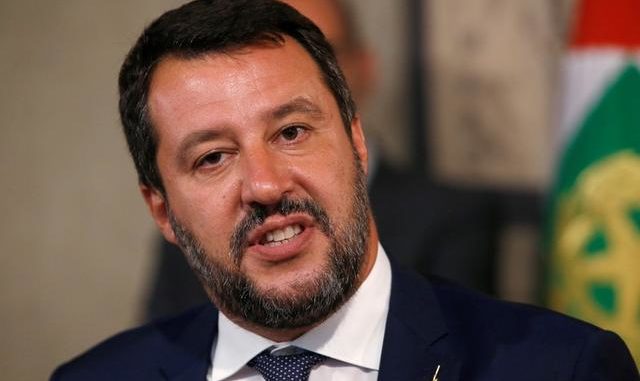
League leader Matteo Salvini led the opposition center-right to a crushing victory in the Italian region of Umbria, results on Monday showed, raising questions about how long the national government in Rome can survive.FILE PHOTO: League leader Matteo Salvini speaks to the media after consultations with Italian President Sergio Mattarella in Rome, Italy, August 28, 2019. REUTERS/Ciro de Luca
Parties in the ruling coalition, the anti-establishment 5-Star Movement and center-left Democratic Party (PD), stood together on a joint ticket for the first time in the Umbrian election, but were crushed by a resurgent Salvini.
The center-right candidate for governor in the small, central region won 57.5% of the vote against just 37.6% for the 5-Star/PD contender — the first time in half a century that the bloc backed by the center-left had lost control of Umbria.
“The results we have seen in Umbria, we are seeing all over the country. This is not a government that represents the Italian people,” Salvini told Radio 24.
“I don’t think it can go on for much longer,” he added, repeating his demand for early parliamentary elections.
RELATED COVERAGE
In a political miscalculation, Salvini walked out of a coalition with 5-Star in August, expecting his move to trigger a national ballot that polls predicted he would easily win.
Instead, 5-Star hooked up with the PD, hoping they could erode Salvini’s support as he languished in opposition. But Sunday’s vote showed the League, pushing an anti-migrant, tax-cutting agenda, is by far Italy’s most popular party.
The League won 37% of the vote, while its nationalist ally Brothers of Italy took 10.4%. Former prime minister Silvio Berlusconi’s Forza Italia, for years the strongest party within the center-right bloc, limped home with a meager 5.5%.
The PD clinched 22.3%, slightly down on what it won in Umbria in European parliamentary elections in May, while 5-Star slumped to 7.4% — half of what it chalked up in the EU ballot.
EMILIA ROMAGNA
5-Star blamed its poor showing on the decision to present a joint candidate with the PD — its traditional political foe before their surprise alliance in August.
“The experiment did not work,” the party said in a statement. “This shows that we can only really represent a third way by looking beyond the two opposite poles.”
The PD took comfort from the fact that its own vote did not collapse in Umbria, but said recent cabinet infighting over the 2020 budget had hurt the image of the ruling coalition.
Prime Minister Giuseppe Conte, who has no party affiliation but is close to 5-Star, said the Umbrian rout should have no bearing on his 2-1/2 month-old government.
“We are here to govern with courage and determination. A regional vote cannot in anyway influence our actions,” Conte told reporters. “If we have no courage, determination or foresight it would be better for us to go home.”
The center-right has won eight straight regional ballots since the last national election in March 2018, and all eyes are now fixed on the Jan. 26 vote in Emilia Romagna — a northern region that has more than four times the population of Umbria and which is the historic heartland of Italy’s left.
“We are coming,” Salvini wrote on Twitter on Monday, announcing his first big campaign rally in Emilia for Nov. 14.
Italian governments have collapsed in the past on the back of weak showings in regional ballots and defeat for the center-left in Emilia Romagna would be a political earthquake that would put enormous strain on the 5-Star/PD coalition.
Some newspapers have speculated that the outgoing European Central Bank President Mario Draghi might be asked to try to form a government of technocrats should the current administration fall.
Salvini dismissed such a prospect as “disrespectful” for Italians. “If this government falls, the only way forward would be new elections,” he said.
Additional reporting by Giselda Vagnoni, Giulia Segreti and Gavin Jones; Editing by Catherine Evans
ROME (Reuters) –
